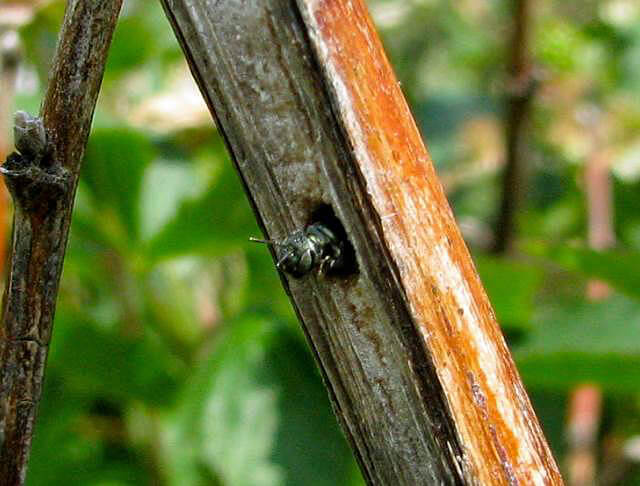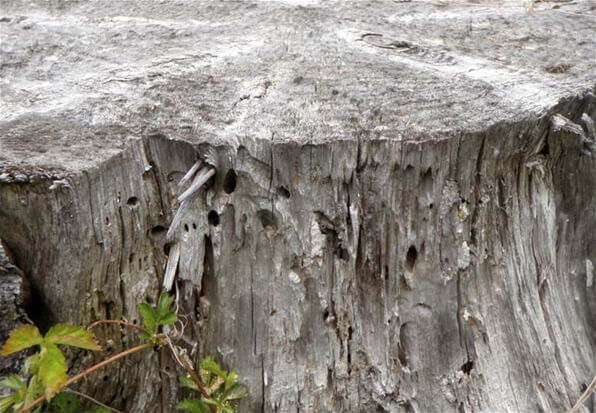
Plants with hollow or pithy stems provide bee nesting habitat. Small carpenter bees and other cavity-nesters excavate the stems. Photo: Nancy Lee Adamson, Xerces Society.
This week, June 22-28, is National Pollinator Week. Pollinators include bees, birds, butterflies, moths, wasps, bats, beetles and other insects. We love pollinators because they help flowers bloom and crops grow.
Many people help pollinators by planting a variety of flowering plants. You can also help by providing bee nesting habitat. Other ways to help include reducing or eliminating your own pesticide use, encouraging your city or county to reduce pesticide use and increase pollinator habitat, and more.
Bee nesting habitat
One way to help bring back the pollinators is to provide bee nesting habitat, said Justin Wheeler in a Xerces Society blog post. Seventy percent of bees nest in tunnels in bare earth. Thirty percent lay their eggs in cavities, such as holes in dead wood or hollow stems. Only honey bees have hives.
When we keep our garden clean and tidy, we are often eliminating natural materials that would be great nesting habitat for bees and other insects. Now you have an excuse to work less in your garden—and help out the bees at the same time.
Here are five ways to support bee nesting habitat.
Rethink your mulch
Use compost-based mulch or shredded leaves for mulch instead of chipped wood products such as bark. These products are light enough to allow ground nesting bees to pass through. They will also suppress weeds, retain water and feed your soil.
And consider mulching just the parts you can see, perhaps the front two feet of a bed. Pollinators can access the uncovered areas in the back.
Grow plants with hollow stems
Plants with hollow or pithy stems include raspberries, Joe Pye weed (Eutrochium spp.), elderberry (Sambucus spp.), hydrangea and others. Cavity nesting bees will make nests in the dried stems and twigs from previous years’ growth. Don’t aggressively cut back or clean up these plants. Consider leaving dead branches alone.
Native bunch grasses also provide habitat. Options include switchgrass (Panicum spp.), Indian grass (Sorghastrum nutans), prairie dropseed (Sporobolus heterolepsis), little bluestem (Schizachyrium scoparium), big bluestem (Andropogon geradii) and grama grass (Bouteloua spp.). They provide nesting sites and protection for bumble bee queens to overwinter. Many of these grasses also serve as butterfly host plants.
Save a (dead) tree, stump or log

The holes in this tree stump were likely made by beetles who are breaking down the wood. Cavity nesting bees will also use these holes. Photo: Don Keirstead, Xerces Society.
Dead woody material provides habitat for all sorts of wildlife. Beetles and carpenter ants burrow into dead wood. Birds go after these insects. The resulting holes provide chambers for cavity nesting bees to lay their eggs. You can add this valuable habitat to your landscape by leaving piles of twigs, branches, logs or a stump in your garden.
Build a better brush pile
Don’t put all of your clippings and pruned branches on the curb to be hauled away. If you have room in your landscape, adding a brush pile is one of the most effective ways you can provide habitat for a diversity of wildlife. And birds use brush piles for shelter.
A brush pile will attract small mammals such as squirrels. The burrows they create will later provide space for bumble bees to nest. Brush piles also provide cover for other ground nesting bees. And they provide food for invertebrates who eventually break the piles down into valuable organic matter for your garden. You could hide the pile behind shrubs or ornamental grasses.
Add bee houses
You may want to build or buy a structure to provide bee nesting habitat. If you make it yourself, you could bundle cuts of bamboo, reeds or other hollow or pithy stems that are closed at one end. Bees will not lay eggs in cavities open at both sides. Hang them in a sheltered location that gets morning sunlight.
Very important: the tubes need to be cleaned or replaced every year to destroy any pathogens or mites. You could also consider renting mason bees and/or leaf cutter bees, along with a house and tube blocks, from Rent Mason Bees.
More information
For more detail about bee nesting habitat, read 5 Ways to Increase Nesting Habitat for Native Bees from the Xerces Society.
Pollinator Protection Pledge
This year, consider signing the Xerces Society’s Pollinator Protection Pledge. More than 10 thousand people have already signed the pledge to protect these important creatures.
Pollinator Protection Pledge. To bring back the pollinators, I will:
- Grow a variety of bee-friendly flowers that bloom from spring through fall.
- Protect and provide bee nests and caterpillar host plants.
- Avoid using pesticides, especially insecticides.
- Talk to my neighbors about the importance of pollinators and their habitat.
The Xerces Society has many pollinator resources specific to the Pacific Northwest. This includes:
- Plant lists
- Pesticide protection
- Identifying, monitoring and conserving pollinators
- Habitat assessment, installation and management
- Seed and plant vendors
Plants that attract pollinators
Here are ideas for a wide variety of plants that attract bees, butterflies and other pollinators.
- Xerces Society: Several plant lists
- Pollinator Partnership: Pacific Lowland Regional Guide
- Great Plant Picks: Plants for Bees
- Great Plant Picks: Plants for Butterflies
- Great Plant Picks: Plants for Hummingbirds
- OSU Extension: 12 plants to entice pollinators to your garden
We can help
Contact In Harmony for help in creating a landscape that is pollinator-friendly. We can design and install a landscape that attracts birds, bees and butterflies. Our natural lawn, tree and shrub care services help your plants thrive and reduce or eliminate the need for pesticide use.
